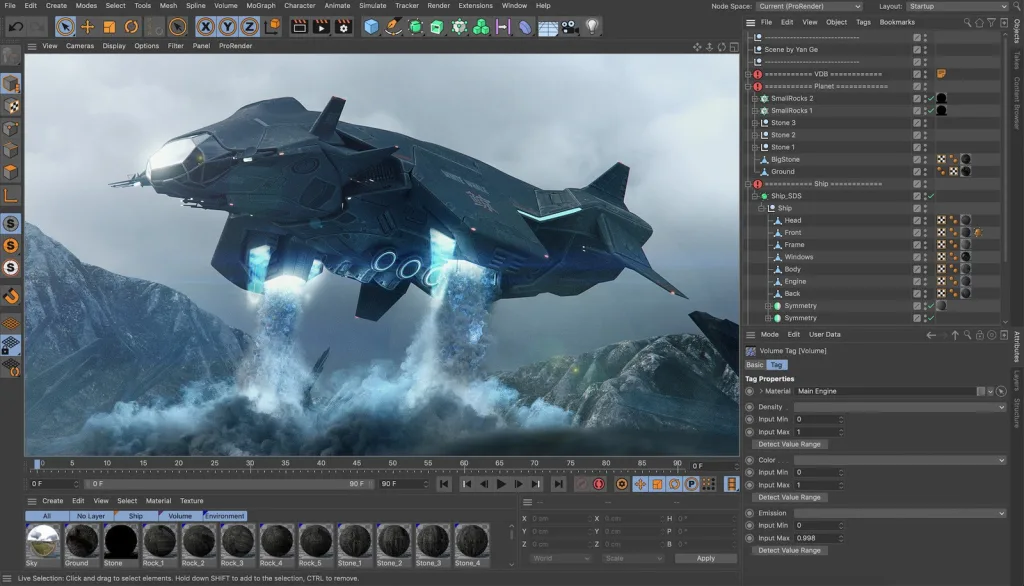
Cinema 4D: Comprehensive Guide for 3D Artists
Introduction to Cinema 4D
Cinema 4D, developed by Maxon, is a powerful 3D modeling, animation, simulation, and rendering software widely used in the 3D design industry. Known for its approachable user interface and extensive toolset, Cinema 4D is highly regarded among both beginners and professional designers. With its flexibility, Cinema 4D serves diverse fields such as film production, advertising, and game development, where it’s used to create stunning visuals and animations.
Since its initial release, Cinema 4D has become a reliable choice due to its constant updates and integration of cutting-edge features that enhance productivity without sacrificing usability. This article will dive into Cinema 4D’s main features, explore its tools, and examine its applications across various creative industries.
History and Development of Cinema 4D
Launched in the early 1990s, Cinema 4D was initially aimed at entry-level 3D designers but has grown significantly in power and versatility over the years. Maxon has continually refined the software, responding to the needs of digital artists by adding new tools and improving the overall workflow. Today, Cinema 4D is a staple in the 3D design community, known for being user-friendly yet powerful enough to handle complex projects. Over the decades, Maxon has expanded Cinema 4D’s capabilities, adding features like advanced sculpting, GPU rendering, and enhanced simulation engines, making it a versatile tool for a variety of creative projects.
With each new release, Cinema 4D introduces updates that align with industry trends, like VR support, motion graphics tools, and GPU-powered rendering options. This dedication to innovation has allowed Cinema 4D to stay relevant and useful in an ever-evolving digital landscape, making it a go-to tool for 3D professionals worldwide.
Core Features and Tools
Cinema 4D provides an extensive toolkit tailored to the needs of 3D artists at every skill level. Its standout features include intuitive modeling tools, powerful rendering engines, and comprehensive animation and simulation capabilities. The software’s modular design also allows users to customize their workspace according to their specific needs, enhancing both efficiency and creativity.
Some key features that set Cinema 4D apart include MoGraph, which is essential for creating complex animations, and its Sculpting system, which allows artists to model highly detailed objects. Cinema 4D’s powerful rendering options, including the built-in Physical Renderer and integration with third-party render engines, make it suitable for producing high-quality, photorealistic visuals. Additionally, its customizable workflow makes Cinema 4D compatible with other design tools, ensuring seamless collaboration across projects.
Modeling Tools and Functionality
One of Cinema 4D’s strengths lies in its sophisticated modeling tools, which include everything from basic geometric shapes to complex subdivision surface modeling. Artists can also leverage parametric modeling and procedural shaders, allowing them to make quick adjustments without affecting the overall design. The Sculpting system enables users to create intricate details, while the Polygon Pen tool facilitates precision in creating and refining shapes.
Cinema 4D’s versatility is further enhanced by tools like the Mirror, Bevel, and Extrude functions, which streamline the modeling process. With support for non-destructive modeling techniques, artists can experiment freely without fear of losing previous work, making Cinema 4D a reliable choice for both fast-paced projects and highly detailed designs.

Applications of Cinema 4D
Owing to its versatility and comprehensive feature set, Cinema 4D is widely used across multiple industries. It is highly popular in the film industry for creating high-quality visual effects and animations, while in advertising, it aids in crafting eye-catching, engaging visuals that captivate audiences. The software’s user-friendly interface also makes it accessible for educational purposes, helping students and professionals alike learn 3D design concepts efficiently.
In addition to its ease of use, Cinema 4D’s real-time rendering capabilities make it ideal for projects that require rapid visualization and adjustments. This flexibility is essential for professionals who need to produce polished results quickly, making Cinema 4D an invaluable tool in high-pressure environments like media production and interactive design.
Animation and Simulation
Cinema 4D’s animation and simulation capabilities are robust and offer extensive options for creating realistic movement and physics. The software includes a dynamics engine that simulates real-world physics, allowing artists to animate objects with realistic motion and interactions. Cinema 4D’s MoGraph toolset, particularly valuable for creating procedural animations, enables users to generate complex and dynamic effects that would be difficult to achieve manually.
Beyond traditional animation, Cinema 4D supports character rigging and motion tracking, making it suitable for character animation and integrating 3D elements into live-action footage. With built-in support for fluid simulations, hair and fur effects, and particle systems, Cinema 4D provides a complete toolkit for animators and visual effects artists looking to bring their ideas to life in a realistic and visually compelling way.



